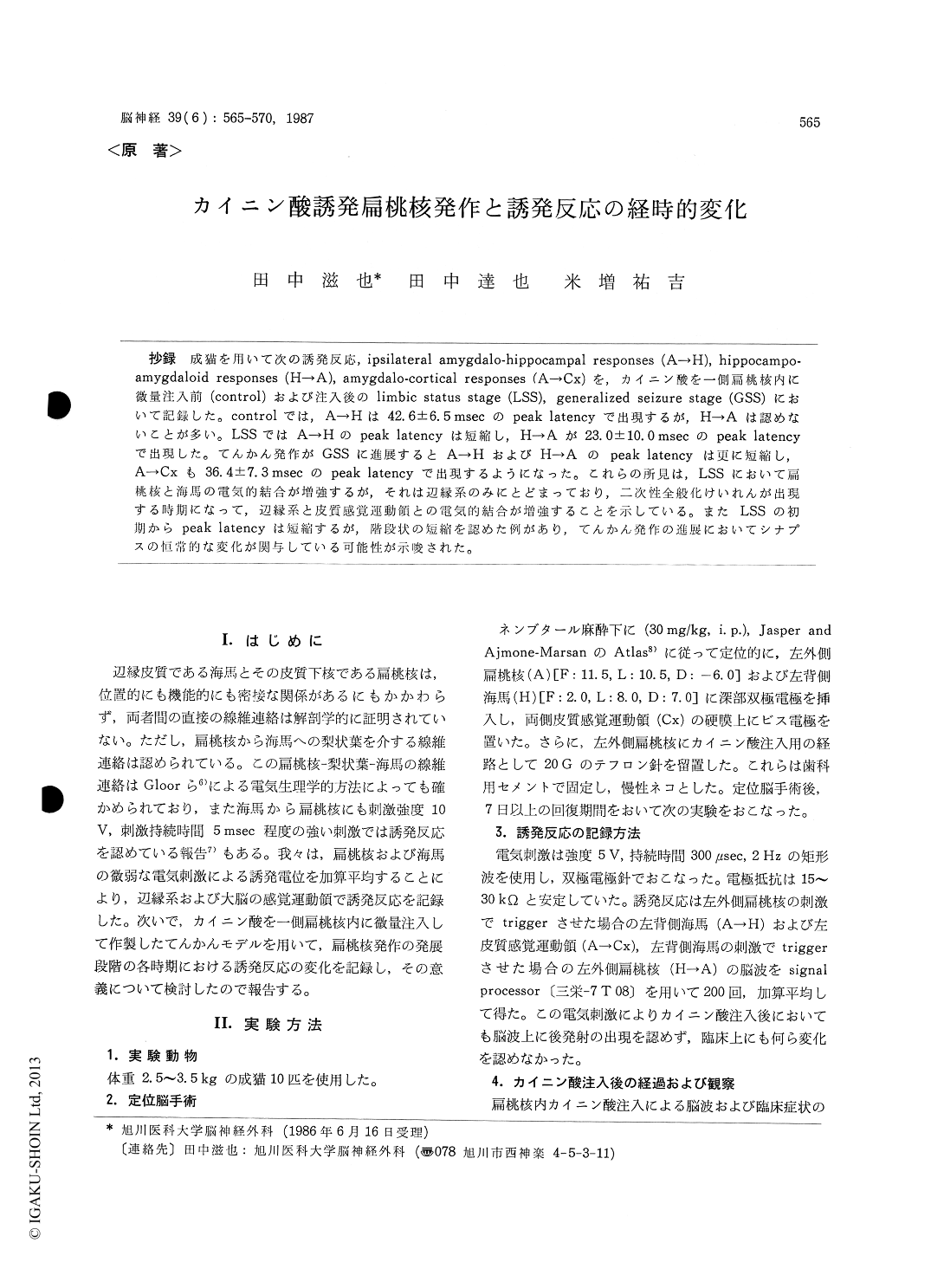Japanese
English
- 有料閲覧
- Abstract 文献概要
- 1ページ目 Look Inside
抄録 成猫を用いて次の誘発反応,ipsilateral amygdalo-hippocampal responses (A→H),hippocampo-amygdaloid responses (H→A),amygdalo-cortical responses (A→Cx)を,カイニン酸を一側扁桃核内に微量注入前(control)および注入後のlimbic status stage (LSS), generalized seizure stage (GSS)において記録した。controlでは,A→Hは42.6±6.5msecのpeak latencyで出現するが,H→Aは認めないことが多い。LSSではA→Hのpeak latencyは短縮し,H→Aが23.0±10.0msecのpeak latencyで出現した。てんかん発作がGSSに進展するとA→HおよびH→Aのpeak latencyは更に短縮し,A→Cxも36.4±7.3msecのpeak latencyで出現するようになった。これらの所見は,LSSにおいて扁桃核と海馬の電気的結合が増強するが,それは辺縁系のみにとどまっており,二次性全般化けいれんが出現する時期になって,辺縁系と皮質感覚迎動領との電気的結合が増強することを示している。またLSSの初期からpeak latencyは短縮するが,階段状の短縮を認めた例があり,てんかん発作の進展においてシナプスの恒常的な変化が関与している可能性が示唆された。
On the basis of careful histological works in-cluding the use of experimental techniques, nearly all of the workers came to the conclusion that no neuronal connections between amygdala and hip-pocampus exist, regardless of close topographycal localization or intimate functional cooperation. We examined ipsilateral amygdalo-hippocampal responses (A-H), hippocampo-amygdaloid re-sponses (H-A) and amygdalo-cortical responses (A-Cx) in normal or epileptic cats by means of evoked potential method.
Stereotaxic operations were carried out in ten adult cats. Bipolar electrodes were placed in the left amygdala and ipsilateral dorsal hippocampus, and stainless screws on the dura over the bilateral anterior sigmoid gyrus. A teflon needle with an inner needle guide was also inserted obliquely into the ipsilateral amygdala. The bipolar elec-trodes allowed both to stimulate and to record the electrical activity. Two hundred rectangular pulses (0.3 msec, 5 V, 2 Hz) were given and evoked re-sponses summed and averaged by a computer.
These evoked studies were made before and after KA injection (1 microgram) into the ipsila-teral amygdala. In controls, only A-H were ob-served. During limbic status stage, H-A began to appear and peak latencies of A-H shortened in accordance with seizure development. During generalized seizure stage, A-Cx was newly ob-served and peak latencies of both A-H and H-A shortened. Peak latencies of the evoked potentials began to shorten soon after development of limbic seizure, and stepwise shortening of peak latencies were recognized in some cases. These results suggested that the transmission at synapses were modified by these exitatory effect of epileptic phenomena.
Spike-related evoked potential method was also applied during limbic status stage and generalized seizure stage triggering by the high amplitude interictal discharges. The latencies of A-Cx by this method were considerably shorter than that of evoked potential method. This discrepancy of peak latencies between ordinarily evoked responses and spike-related evoked responses suggests some different mechanism in propagation of electrical activity during seizure.

Copyright © 1987, Igaku-Shoin Ltd. All rights reserved.


